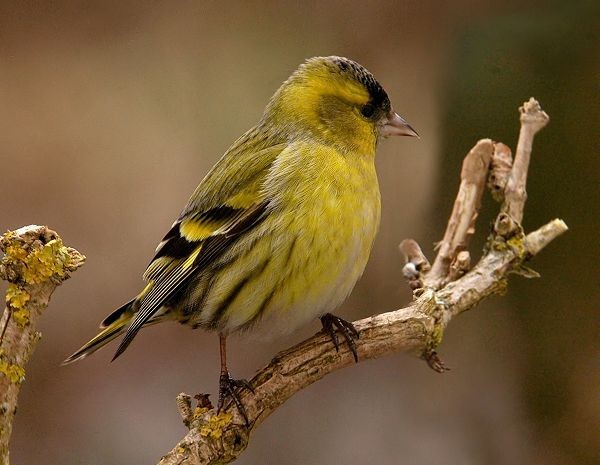 |
| Siskin: Wyre Forest, Worcs (photo: John Robinson). |
I don't know about you but I often glance out into my garden when I'm eating my breakfast in the morning. Over my toast and the pages of my newspaper, I make a mental note of what is going on out there. Like a lot of people I put food out for the birds and take great pleasure in watching it be devoured by a variety of species. Robins belligerently defending some food on the lawn or the flash of colour that signals the arrival of a Goldfinch are all enjoyed equally. My garden is pretty small and is in a built-up area but it is amazing the number of species that I have recorded from it. This just goes to show how important private gardens are for birds. Gardens comprise a large percentage of the UK's land area — in fact more of the UK's land area is garden than nature reserve!
Wouldn't it be great if the observations that I made in my garden could contribute to our understanding of what is happening to UK bird populations? Well, luckily for the sake of this article, they can and do!
Over 35 years ago the British Trust for Ornithology (BTO) began the Garden Bird Feeding Survey (GBFS), which was the first scheme of its kind to look at which birds were using our gardens in the winter months (October-March). However, it was felt that there was a need to monitor garden birds all year round and in 1995 the BTO/CJ Garden BirdWatch survey was launched. It has grown steadily since then and now has 16,500 participants from Shetland to the Scillies and from Belfast to Bexhill.
So what does it involve? Well, participants are asked to record the maximum number of birds of each species that they see at any one time each week. You can record for five minutes over a cup of tea or for an hour while gardening. It's really up to you. These observations can be recorded on a computer-readable form and posted in or can be entered online at the Garden BirdWatch website. It really is that simple.
Over the last 11 years the BTO has collected millions of individual bird observations from a multitude of different gardens. These data enable us to calculate what is called the reporting rate for each species. This is basically the percentage of gardens submitting data that have recorded a particular species. So what do the data and reporting rates tell us?
 |
| Woodpigeon: Congleton, Cheshire (photo: Mike Atkinson). |
Well, as you might expect there have been winners and losers. One of the biggest winners has been the Woodpigeon, which has seen a steady increase in reporting rate since the survey began.

What about the losers? Like other surveys, Garden BirdWatch has seen a drop in House Sparrows, with these birds decreasingly steadily over the last decade. The reasons for this decline are still not fully understood but studies suggest that a lack of insects on which to feed young is at least in part to blame.

As this survey is all year round it is also able to pick up subtle differences in the use of gardens by birds between the seasons. For instance, the Blackbird is recorded in about 97% of gardens throughout most of the year; however, during late summer and early autumn this figure drops to about 75%. This isn't a result of a mass die-off of young birds but is a consequence of birds making good use of natural foods such as berries, which they feast on in the wider countryside. By November/December these birds have returned to our gardens and the reporting rate is back to around 97%.

Siskins show a very different pattern. Some gardens have visiting Siskins all year round, but for most, early March is the peak visiting times when, in a good year, up to 40% of gardens record them.

From the graph you can see that the winter of 2004/2005 was very poor in terms of Siskins in gardens and this corresponds with information from birders in general who witnessed poor numbers during this period.
More formal analysis can be carried out too. Recently, scientists at the BTO and the University of Sheffield used the data from this survey to publish a scientific paper in the Journal of Applied Ecology, entitled "Trends in the use of private gardens by wild birds in Great Britain 1995–2002". This study found that 18 species of birds including Woodpigeon and Mistle Thrush showed significant trends in their use of gardens over time, with some species increasing and others decreasing. What was especially interesting was that these trends often followed the increases and declines seen in results from the BTO/RSPB/JNCC Breeding Bird Survey, which monitors breeding populations across a range of different habitats. Also, the three species that showed the greatest declines in their garden use during this period (House Sparrow, Song Thrush and Starling) were species that are "Red-listed" as being of high conservation concern; that is, their populations have suffered serious declines in recent years.
 |
| Starling: Fairhaven Lake, Lancashire (photo: Sue Tranter). |
This tells us that Garden BirdWatch and the way it is constructed can give us meaningful insights into what is happening to birds over time, making it a very powerful tool for ecological research.
So what does the future hold? Well, the survey will continue to monitor the ups and downs of garden birds but it is hoped that we can get more detailed regional breakdowns so that we can provide information at a local level to bird recorders and policy makers. To this end we need more people recording so why not give it a go and become a 'citizen scientist'.
To find out more about the Garden BirdWatch, go to http://www.bto.org/gbw/. For more information and to receive a free information pack about the survey, email gbw@bto.org quoting BirdGuides.

